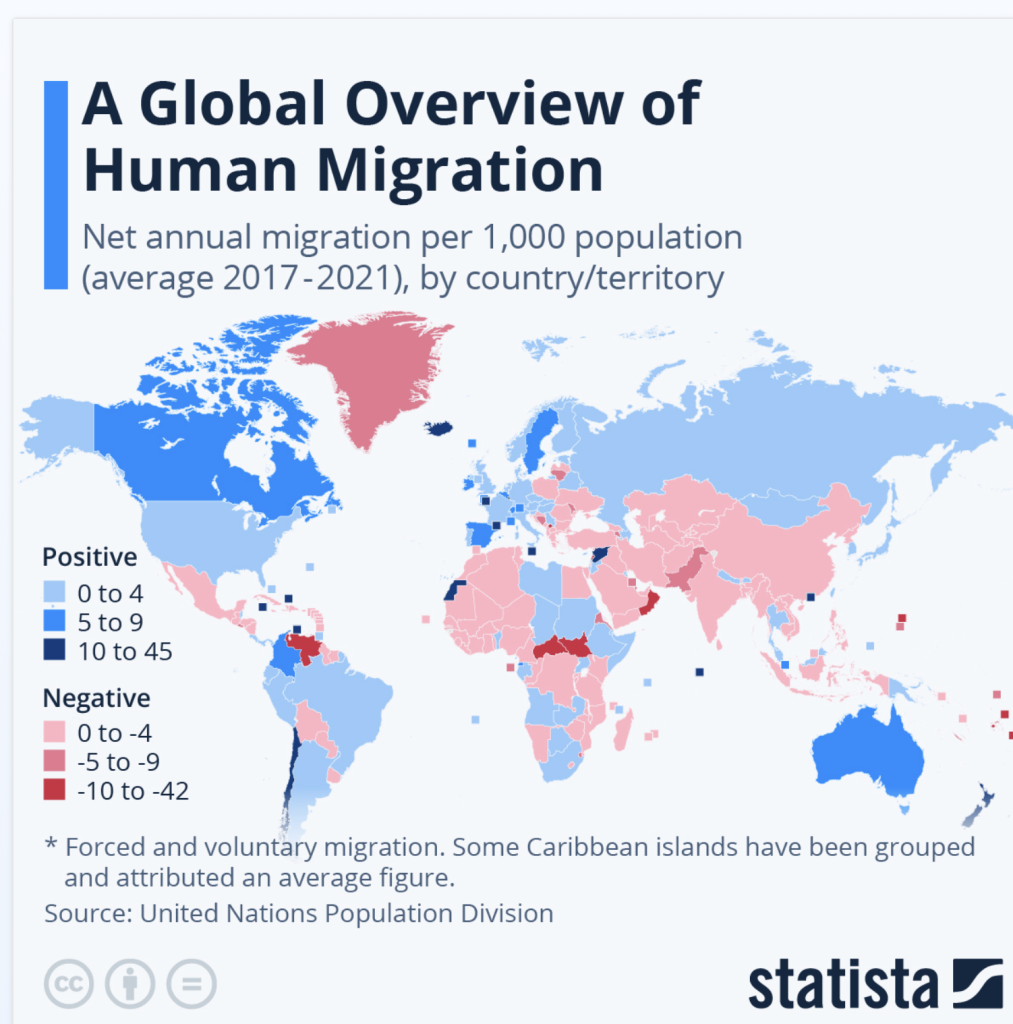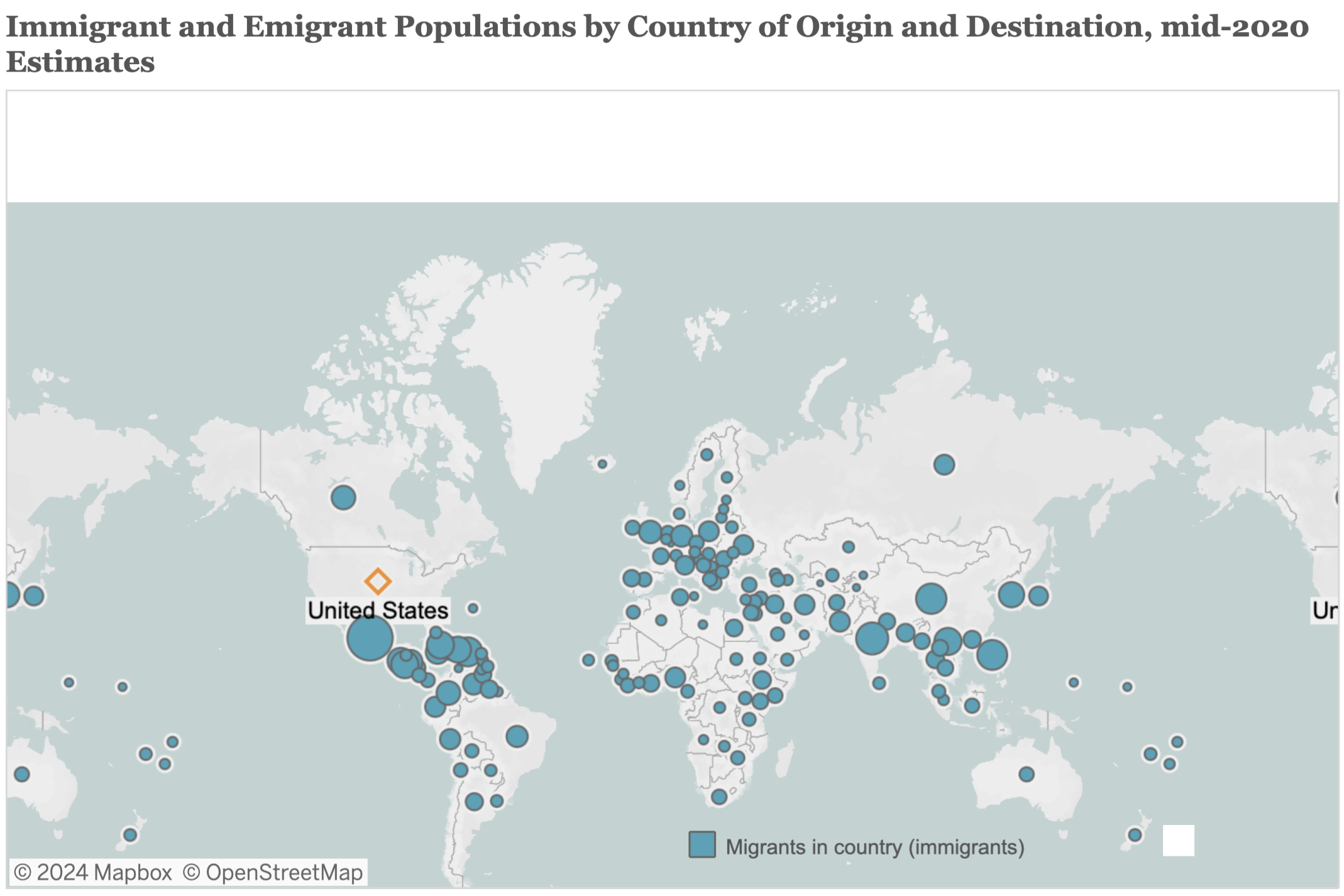Chapter 3: Migration
3.1 Introduction – Types of Migration
Key Questions
In this chapter we explores how and why people migrate. We discuss where people migrate to, both within countries and across country borders. and how governments and globalization impact migration. While doing this we seek to find answers to the following questions:
- What are some of the ways that are collectively referred to as ‘human migration’?
- What is the general relationship between demographic factors and migration across time ?
- What are some general migration patterns on selected continents?
- Why do people migrate?
- How does globalization affect migration?
Migration is the physical movement of people from one place to another; it may be over long distances, such as moving from one country to another, and can occur as individuals, family units, or large groups.
This process can create two groups of people:
- Immigrants: those who are moving into a new region or country
- Emigrants: those who are moving out of their home regions or countries
We differ between internal migration which describes the movement within one country and international migration which describes the movement from one country to another. Migration can be voluntary migration which is based on individual choice or forced migration when an individual must leave against his or her will.
STATISTA reports that the number of international migrants amounted to 281 million in 2020, which is equivalent to 3.6 percent of the world’s population.

Source: Martin Armstrong (2022, September 28). A global overview of human migration. Statista.
This map offers a comprehensive view of global migration trends, illustrating the annual net migration (arrivals minus departures) for all countries and territories relative to their population size. From 2017 to 2021, the regions experiencing the highest rates of emigration were the Marshall Islands and American Samoa in the Pacific Ocean, followed by Lebanon and Venezuela. These areas, some of which are facing severe economic challenges, saw an average net loss of 28 to 42 inhabitants per 1,000 people per year during this period.
Ultimately, the distance people migrate depends on a variety of factors. The economic factor is by far the most common but environmental conditions, gender issues, family status, instability of the home country and cultural factors all play major roles in the decision-making process. For example, long-distance migration tends to involve males looking for employment and traveling by themselves rather than risking to take their families.
Examples of combining categories of migration
International voluntary migrationEuropean migration to the United States, from colonial times through especially the early 1900’s was largely voluntary. Reasons for migration were varied (religious freedom, economic opportunities, and more). Asian and Latin American migration to the United States has likewise been largely voluntary. International voluntary migration can be temporary; perhaps after earning an education or enough money, people may return to their native countries. |
Internal voluntary migrationThe Great Migration of African Americans from the rural South to the industrial North occurred in waves from 1910 to 1970. Large scale agricultural mechanization led to less need for workers on southern farms, while at the same time massive industrialization in northern cities called for new migrant workers. This was a massive population shift as African Americans were more concentrated in the South. |
International forced migrationThe transatlantic slave trade is an example of international forced migration. People from West Africa were forcibly taken from their homes, packed tightly into ships, and sold into slavery onto forced labor camps called plantations in the New World. This is still classified as migration, which is just about if movement occurred, but was clearly not done by individual choice from the migrants. |
Internal forced migrationThe Trail of Tears is perhaps the best known American example of internal forced migration. The Cherokee Nation was forced to leave their treaty-protected homelands in Georgia for Oklahoma in the 1830’s. It is estimated that about a quarter of the 16,000 Cherokees died in the forced march to Oklahoma. |
“Examples of combining categories of migration” by Christine Rosenfeld & Nathan Burtch is licensed under CC BY-NC-SA 4.0.
The earliest migrants originated from Eastern Africa, but exactly when migrants reached North America is still debated. There is evidence of early human remains in North America about 13,000 years ago, but potential cultural artifacts (i.e. stone tools) from 33,000 years ago have also been recently discovered.
Today, many countries such as the United States, receive many immigrants from other countries. However, these countries may also be countries of emigration, as retirees decide to leave their birth countries to take advantage of the lower cost of living elsewhere, or as long-term migrants decide to return to their birth countries after retirement.

Source: A screenshot of “Immigrant and Emigrant Populations by Country of Origin and Destination, mid-2020 Estimates” map.

